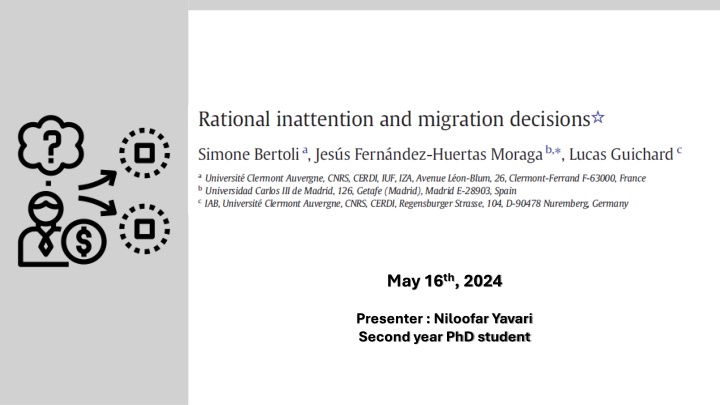
Migration Decisions: Information Frictions and Economic Conditions
Delve into how migrants make destination choices amidst uncertainty by investing in information acquisition. Explore the impact of economic conditions on migration patterns and uncover systematic differences across origins in response to various destinations. Gain insights into the complex dynamics of migration decision-making and the influence of information frictions on migration flows.
Download Presentation

Please find below an Image/Link to download the presentation.
The content on the website is provided AS IS for your information and personal use only. It may not be sold, licensed, or shared on other websites without obtaining consent from the author. If you encounter any issues during the download, it is possible that the publisher has removed the file from their server.
You are allowed to download the files provided on this website for personal or commercial use, subject to the condition that they are used lawfully. All files are the property of their respective owners.
The content on the website is provided AS IS for your information and personal use only. It may not be sold, licensed, or shared on other websites without obtaining consent from the author.
E N D
Presentation Transcript
May 16th, 2024 Presenter : Niloofar Yavari Second year PhD student
Overview of Paper Traditional Assumption >>> migrants have all necessary information, but uncertainty may persist whenchoosinga destination. strategicdecisions To cope with uncertainty >>> Estimating Gravity Model derived from a location-decision problem destinations faceuncertainty Benefitsin expectations Inaccurate This estimation of gravity model>>> reflecting migrants' incentives to gather information before moving. Using data on bilateral migration flows Findings face uncertainty inaccurateexpectations migrants invest more in information acquisition when economic conditions change in potential destinations, leading to increased migration flows.
What the paper is going to say? significant contributions to understanding migration decisions by addressing rational inattention when utility follows a specific distribution, all destination options are chosen with positive probability allows us to uncover systematic differences across origins in how migration flows respond to economic conditions in destination countries complex dynamics of migration decision-making and provides insights into how information frictions shape migration patterns
Theory Implementation Choice 4 Choice 2 These options are collectively referred to as the choice set. Each destination offers a certain level of utility >>> determined by factors like job opportunities and living costs Choice 3 Choice 1 Costly Process to obtain accurate information They aim to maximize their expected utility by selecting the destination with the highest expected payoff based on the information they have. Gathering Information The probability of choosing a specific destination >>> depends on both the person's belief about the utilities and the information they acquire. The model streamlines decision-making by linking acquired information directly to destination choices, simplifying the process to assess the likelihood of selecting each destination.
The migrant's decision problem is then expressed as maximizing the expected payoff minus the cost of information acquisition, subject to constraints. Cost function cost of acquiring information constraints ensure that probabilities are non- negative and sum to 1. This problem is characterized by the parameter (? > 0 ) and the distribution function ( f(v) ) representing the payoff distribution.
Solution for model finding the best way to decide the likelihood of picking each destination ( presented by Mat jka and McKay ,2015) the likelihood of picking each destination Benefits of each option Cost of each option along with a parameter called Using Original formula becomes simpler, focusing only on the overall chances of picking each destination. But we don't know for sure which destinations are in( B ) and finding a straightforward solution to the simplified problem isn't easy.
The consideration set comprises potential alternatives for solving the maximization problem. Consideration set 1-Complexity reduction Generally, there are 2N - 1 possible sets. However, when payoffs follow similar patterns, there are only N subsets, simplifying the decision process. Represent sum of values possible outcomes of random variable ? 2-Nested Structure Represent Payoff associated with alternatives Payoff associated with each alternatives are different but follow similar distribution pattern. Then Narrow down to N subset. Probability density function 3-simplified Same distribution Pattern among across alternatives To solving unconditional probabilities .
Optimal cost of information Procedure of optimization of information acquisitions : 1. we simplify the model to just two alternatives 2. Calculating Choice Probability by formula called logistic distribution 3. The cost of gathering information about each option depends on how likely it is to be chosen. Resulted in The total cost of gathering info is highest when both options are equally likely to be chosen. More money is spent on learning about the less attractive option. As the likelihood of picking Option 1 increases, the proportion of money spent on gathering info about it decreases.
From theory to data Data on international migration flows from Abel (2018), covering 203 countries over the period 1960 to 2015. estimate the "value of information," a proxy for the cost of information acquisition. there's no distinct geographical trend in the data, with significant variability i within regions like Latin America and Sub-Saharan Africa. Paper focuses on seven consecutive five-year periods between 1980 and 2015, with a total of 263,008 observations.
Economic analysis Implementing Gravity model for Rational Inattention For simplifying the economic analysis and reveal that how appealing a destination is, the economic factor (like real GDP per person), and the costs involved in moving. a method called Poisson pseudo-maximum-likelihood to estimate the equations. Consider migration flows >>might be Zero
main findings on the relationship between the value of information and migration different variant of the empirical counterpart for the value of information for a specific origin country j in a five-year period starting in year t. The findings indicate that the coefficient (^ ) of the interaction between destination GDP per capita and the time-varying origin-specific value of information is consistently positive and statistically significant. increase in the value of w(r)jt is associated with an increase in the elasticity of the bilateral migration rate with respect to GDP per capita at destination.
Model Prediction include lagged data from all destinations robustness of our results by excluding the primary origin- time specific destination from the analysis. Reality migrants would consider all options when deciding where to move As shown in Table 3, although the estimated coefficient for decreases slightly across all definitions of the value of information, it remains statistically significant and consistent with our main findings migration flows are zero. migrants forming smaller consideration sets
Outline of the paper and my research Investigate how rational inattention influences migrant destination choices and whether migrants prioritize specific aspects of destinations due to cognitive limitations. Objective My research aims to : explore onward migration within specific migrant communities in Japan. focusing on the motivations behind internal relocation within their new destination. subsequent relocation across different regions worldwide. Looking to the experience of living in new environments motivates migrants. examine the relationship between the experience of international relocation and onward migration. exploring how these two phenomena interact and influence each other. ( time span concept refer to the fact that having spent years in one destination equips migrants with more knowledge about opportunities and shortcomings of their current place.) Utilize international migration databases, longitudinal surveys, and possibly experiments to gather data on migrants' decision-making processes. Data Employ econometric techniques like panel data analysis or structural equation modeling to quantify the relationship between rational inattention and migration decisions Method Challenges include identifying suitable proxies for rational inattention and addressing endogeneity concerns Problem Illustrate how rational inattention impacts migration decisions. suggesting migrants prioritize certain destination attributes due to cognitive limitations. Results


